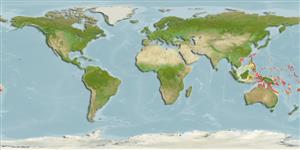>
Gobiiformes (Gobies) >
Gobiidae (Gobies) > Gobiinae
Etymology: Ctenogobiops: Greek, kteis, ktenos = comb + Latin, gobius = gudgeon + Greek, ops = appearance (Ref. 45335); mitodes: Name from Greek 'mitodes' meaning theadlike, refers to the filamentous 2nd dorsal spine of adults..
More on authors: Randall, Shao & Chen.
Environment: milieu / climate zone / depth range / distribution range
Écologie
marin récifal; profondeur 9 - 21 m (Ref. 75863). Tropical
Western Pacific.
Taille / Poids / Âge
Maturity: Lm ? range ? - ? cm
Max length : 5.3 cm SL mâle / non sexé; (Ref. 75863)
Description synthétique
Clés d'identification | Morphologie | Morphométrie
Épines dorsales (Total) : 6 - 7; Rayons mous dorsaux (Total) : 11; Épines anales: 1; Rayons mous anaux: 11. Characterized by whitish body color with four longitudinal rows of dark brown spots (midlateral row spots largest and horizontally elongate); large anterior dark spots of midlateral row often encircled by blue dots; cheeks with row of three dark spots; behind lower edge of eye with oblique blue and yellow mark followed by similar marks on opercle and preopercle; curved blue and yellow line/dashes from behind upper eye to below of dorsal fin origin; lower part of pectoral fin with elliptical white spot; longitudinal scale series 52-56; opening of gill extending slightly anterior to vertical at posterior edge of preopercle; greatest depth of body 4.3-5.0 in SL; rounded caudal fin, shorter than length of head (Ref. 90102).
Collected by rotenone and spear from silty, sand and rubble bottoms (Ref. 75863). Also found in lagoons (Ref 90102).
Life cycle and mating behavior
Maturities | Reproduction | Spawnings | Egg(s) | Fecundities | Larves
Randall, J.E., K.-T. Shao and J.-P. Chen, 2007. Two new shrimp gobies of the genus Ctenogobiops (Perciformes: Gobiidae), from the Western Pacific. Zool. Stud. 46(1):26-34. (Ref. 75863)
Statut dans la liste rouge de l'IUCN (Ref. 130435)
Menace pour l'homme
Harmless
Utilisations par l'homme
Outils
Articles particuliers
Télécharger en XML
Sources Internet
Estimates based on models
Preferred temperature (Ref.
123201): 25.6 - 29.3, mean 28.5 °C (based on 1064 cells).
Phylogenetic diversity index (Ref.
82804): PD
50 = 0.5020 [Uniqueness, from 0.5 = low to 2.0 = high].
Bayesian length-weight: a=0.00708 (0.00333 - 0.01504), b=3.09 (2.92 - 3.26), in cm total length, based on LWR estimates for this (Sub)family-body shape (Ref.
93245).
Niveau trophique (Ref.
69278): 3.3 ±0.4 se; based on size and trophs of closest relatives
Résilience (Ref.
120179): Haut, temps minimum de doublement de population inférieur à 15 mois (Preliminary K or Fecundity.).
Fishing Vulnerability (Ref.
59153): Low vulnerability (10 of 100).
Nutrients (Ref.
124155): Calcium = 215 [93, 463] mg/100g; Iron = 0.956 [0.473, 1.912] mg/100g; Protein = 17.8 [15.8, 19.5] %; Omega3 = 0.0977 [, ] g/100g; Selenium = 23.1 [9.5, 56.5] μg/100g; VitaminA = 151 [39, 564] μg/100g; Zinc = 2.66 [1.66, 4.09] mg/100g (wet weight);
